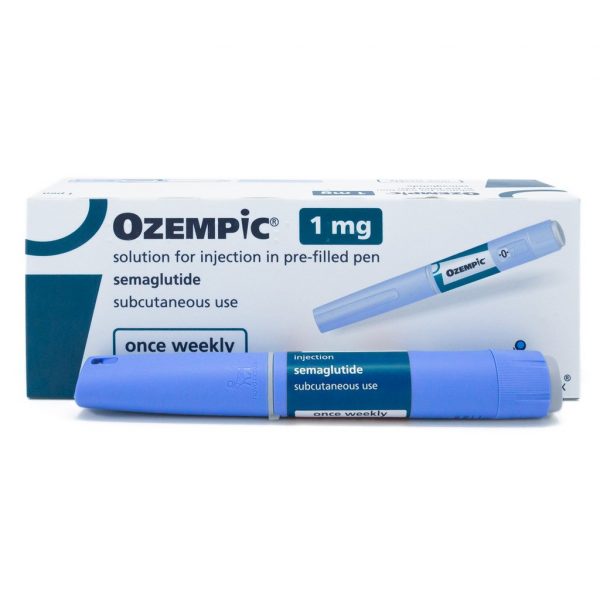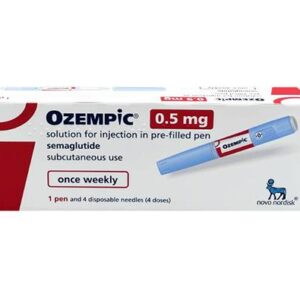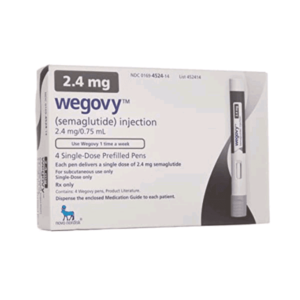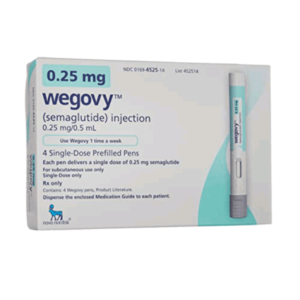Ozempic weight loss Netherlands |Bestel Ozempic Online Nederland
What Is Ozempic?
Ozempic weight loss Netherlands. Ozempic (semaglutide) is a drug that’s used in people with type 2 diabetes. Ozempic is given as an injection under your skin.
Ozempic can be prescribed to adults with type 2 diabetes to:
- lower certain risks in people who also have heart disease, including heart attack and stroke.
- help manage blood sugar levels, along with lifestyle improvements in diet and exercise.
To learn more about Ozempic’s approved uses, see “What is Ozempic used for?” below.
Doctors may also prescribe Ozempic off-label for weight loss or weight management. (With off-label use, a drug that’s approved for certain conditions is prescribed for another purpose.) For details, see “Is Ozempic used for weight loss?” below.
Ozempic basics
Ozempic contains the active ingredient semaglutide. (An active ingredient is what makes a drug work.) It belongs to a class of drugs called glucagon-like peptide-1 receptor agonists.
Ozempic is a brand-name medication that’s not currently available in generic form. Ozempic Netherlands price
Boxed warning: Risk of thyroid cancer
Ozempic has a boxed warning Trusted Source, which is a serious warning from the Food and Drug Administration (FDA).
The FDA issued this boxed warning because Ozempic has been shown to cause thyroid tumors and thyroid cancer in animals. It isn’t known if Ozempic can cause thyroid tumors or medullary thyroid cancer in humans. If you have a family or personal history of medullary thyroid cancer or a rare endocrine condition called multiple endocrine neoplasia syndrome type 2, you should not take Ozempic.
Parla con il tuo medico se soffri di una di queste condizioni o se ne hai una storia familiare.
For more information, see the “What are Ozempic’s side effects?” section below.
Ozempic è usato per perdere peso?
Ozempic is not approved by the Food and Drug Administration (FDA) for use as a weight management medication. But you might lose weight while you’re taking Ozempic. That’s because the medication decreases your appetite.
In some cases, Ozempic is prescribed off-label for weight management, though this isn’t likely. (With off-label use, a drug that’s approved for certain conditions is prescribed for another purpose.) It’s more likely that your doctor would prescribe Wegovy, which contains the same active ingredient* as Ozempic, called semaglutide. Wegovy is FDA-approved to be prescribed for weight management.
L'assicurazione potrebbe non coprire gli usi off-label di Ozempic. Chiedi al tuo medico per maggiori informazioni.
Se sei interessato a utilizzare semaglutide per la gestione del peso, parla con il tuo medico. Possono aiutarti a determinare il farmaco migliore per te e se è appropriato prescrivere Ozempic off-label.
Come funziona Ozempic per la perdita di peso
Ozempic funziona per aiutarti a perdere peso in alcuni modi:
- Rallenta la velocità con cui lo stomaco si svuota dopo aver mangiato. Questo rallenta il processo di digestione e può aiutarti a sentirti sazio più a lungo.
- Il farmaco imita un ormone chiamato GLP-1 che il tuo corpo produce naturalmente. Questo ormone aumenta il senso di sazietà (sentirsi sazio o soddisfatto dopo aver mangiato).
These effects can also decrease your appetite. For details about how Ozempic works, you can refer to the “How does Ozempic work?” section just below.
Ozempic è sicuro ed efficace per la perdita di peso? Quanto peso potrei perdere con Ozempic?
As long as you use Ozempic as your doctor prescribes, it should be safe to use for weight loss.
La quantità di peso che potresti perdere durante il trattamento con Ozempic dipende da una varietà di fattori, tra cui per quanto tempo usi Ozempic e come sono la tua dieta e la tua routine di esercizio fisico. Dipende anche da come il tuo corpo risponde al farmaco.
For more information about Ozempic’s effectiveness for weight loss, you can refer to this comprehensive article about Ozempic for weight loss. You can also talk with your doctor. They can discuss Ozempic’s studies in more detail, and how your lifestyle might affect your weight management treatment.
*Un principio attivo è ciò che fa funzionare un farmaco.
Come funziona Ozempic?
Ozempic agisce in diversi modi per abbassare i livelli di zucchero nel sangue nelle persone con diabete di tipo 2. Il farmaco riduce anche i rischi legati al cuore nelle persone con diabete e malattie cardiache.
Il farmaco fa questo:
- Increasing the amount of insulin your body makes after a meal so that your blood sugar levels won’t get too high. Insulin is a hormone that lowers your blood sugar levels.
- Rallentare il movimento del cibo attraverso lo stomaco per prevenire un forte aumento dei livelli di zucchero nel sangue.
- Ridurre la quantità di zucchero rilasciata nel flusso sanguigno.
Il medico o il farmacista possono fornire dettagli su come funziona Ozempic nel corpo.
Quali sono gli effetti collaterali di Ozempic?
Come la maggior parte dei farmaci, Ozempic può causare effetti collaterali lievi o gravi. Gli elenchi seguenti descrivono alcuni degli effetti collaterali più comuni segnalati con Ozempic. Questi elenchi non includono tutti i possibili effetti collaterali.
Il medico o il farmacista può dirti di più sui potenziali effetti collaterali di Ozempic. Possono anche suggerire modi per contribuire a ridurre gli effetti collaterali.
Effetti collaterali lievi
Ecco un breve elenco di alcuni degli effetti collaterali lievi che sono stati segnalati con Ozempic. Per conoscere altri effetti collaterali lievi, parla con il tuo medico o il farmacista.
Lievi effetti collaterali di Ozempic possono includere:
- stipsi
- diarrea
- nausea
- dolore addominale
- vomito
Gli effetti collaterali lievi di molti farmaci possono scomparire nel giro di pochi giorni o un paio di settimane. Ma se diventano fastidiosi, parla con il tuo medico o il farmacista.
Effetti collaterali gravi
Possono verificarsi effetti collaterali gravi da Ozempic, ma non sono comuni. Se manifesti effetti collaterali gravi da Ozempic, chiama immediatamente il medico. Ma se pensi di avere un'emergenza medica, dovresti chiamare il 911 o il numero di emergenza locale.
Gli effetti collaterali gravi possono includere:
- nausea
- pancreatite* (infiammazione del pancreas)
- boxed warning: risk of thyroid tumors or thyroid cancer*
- diabetic retinopathy (damage to your eyes that’s caused by diabetes)
- hypoglycemia (low blood sugar)
- gallbladder disease (which can include gallstones and inflammation of your gallbladder)
- reazione allergica*
* Per ulteriori informazioni su questo effetto collaterale, vedere la sezione "Focus sugli effetti collaterali" di seguito.
Focus sugli effetti collaterali
Scopri di più su alcuni degli effetti collaterali che Ozempic può causare.
Avvertimento in scatola
Ozempic has a boxed warningTrusted Source, which is a serious warning from the Food and Drug Administration (FDA).
Ozempic has been shown to cause thyroid tumors and thyroid cancer in animals. It isn’t known if Ozempic can cause thyroid tumors or medullary thyroid cancer in humans.
If you have a family or personal history of medullary thyroid cancer or a rare endocrine condition called multiple endocrine neoplasia syndrome type 2, you should not take Ozempic.
Parla con il tuo medico se soffri di una di queste condizioni o se ne hai una storia familiare.
Cosa potrebbe aiuto?
Assicurati di chiamare immediatamente il medico se manifesti segni o sintomi di un tumore alla tiroide durante l'assunzione di Ozempic. Questi includono:
- un nodulo sul collo
- raucedine prolungata nella voce
- fiato corto
- difficoltà a deglutire
nausea
Ozempic può causare nausea, soprattutto quando si inizia a prendere il farmaco o quando si cambia la dose. Di solito, la nausea dovrebbe scomparire dopo pochi giorni.
But keep in mind that nausea can also be a symptom of pancreatitis (inflammation in your pancreas). And pancreatitis is a serious side effect of Ozempic.
Se soffri di nausea che non scompare dopo alcuni giorni, peggiora o diventa grave, chiama immediatamente il medico. Ozempic weight loss Netherlands
Cosa potrebbe aiuto?
Se soffri di nausea durante l'assunzione di Ozempic, il medico può suggerirti modi per aiutarti a gestire i sintomi. Questi possono includere l'assunzione di farmaci da banco o su prescrizione fino a quando la nausea non migliora. Assicurati di consultare il tuo medico prima di assumere qualsiasi farmaco per la nausea con Ozempic.
Pancreatite
Ozempic può causare pancreatite (infiammazione del pancreas). Questa è una condizione seria.
Chiama immediatamente il tuo medico se hai qualche sintomo di pancreatite. Questi possono includere:
- dolore, dolorabilità o gonfiore nella parte superiore dell'addome
- nausea
- vomito
I medici in genere non prescrivono Ozempic se hai avuto pancreatite in passato.
What might help
If needed, your doctor can order tests to check if you have pancreatitis. They’ll stop your Ozempic treatment if necessary and discuss changes to your treatment plan. Some people may have an allergic reaction to Ozempic. Symptoms of a mild allergic reaction can include:
ALLERGIC REACTION
Some people may have an allergic reaction to Ozempic. Symptoms of a mild allergic reaction can include:
- rash
- itchiness
- flushing (temporary warmth, redness, or deepening of skin color)
A more severe allergic reaction is rare but possible. Symptoms of a severe allergic reaction can include swelling under your skin, typically in your eyelids, lips, hands, or feet. They can also include swelling of your tongue, mouth, or throat, which can cause trouble breathing.
What is Ozempic’s dosage?
Your doctor will recommend the dosage of Ozempic that’s right for you. Below are commonly used dosages, but always take the dosage your doctor prescribes.
Form and strengths
Ozempic comes as a liquid solution inside prefilled, disposable pens. The following table shows which strengths Ozempic pens come in. The strengths are written as milligrams of semaglutide (Ozempic’s active drug) per milliliter of solution (mg/mL).
| Strength | Dose given per injection. |
| 2 mg/1.5 mL (this may also be written as 1.34 mg/mL) | 0.25 mg or 0.5 mg. |
| 2 mg/3 mL (0.68 mg/mL) | 0.25 mg or 0.5 mg |
| 4 mg/3 mL (1.34 mg/mL) | 1 mg |
| 8 mg/3 mL (2.68 mg/mL) | 2 mg |
Recommended dosages
You’ll inject Ozempic once each week. You should use the medication on the same day each week. And try to inject it at about the same time on each of those days.
Your doctor may start you on a low dose of Ozempic for the first 4 weeks of treatment. This way, they can see how well Ozempic is working for you. After this, your doctor will likely increase your dose. Your adjusted dose will depend on your blood sugar levels and other factors.
Each Ozempic pen holds several doses of the drug. Your doctor or pharmacist will explain when you need to throw away each pen and start using a new one.
Questions about Ozempic’s dosage
Below are some common questions about Ozempic’s dosage.
- What if I miss a dose of Ozempic? If you miss a dose of Ozempic, take the drug as soon as you remember. But only do this if it’s within 5 days of your last dose. If it’s been more than 5 days, skip the missed dose and wait until it’s time for your next scheduled dose. Taking two doses too close together could lead to dangerously low blood sugar levels. If you miss a dose, check your blood sugar levels regularly to make sure they’re within the standard range. You might find a reminder app like Medisafe useful for staying on track with your weekly injections.
- Will I need to use Ozempic long term? If Ozempic works well for your condition, your doctor may have you take the medication long term. Ask your doctor about the benefits and risks of using Ozempic long term, including its side effects.
- How long does Ozempic take to work? Ozempic starts to work shortly after it’s been injected. After you start using Ozempic, your body may take several weeks to get used to it and to get the full benefit. Depending on how you’re doing with Ozempic, your doctor may then adjust your dose. Follow your doctor’s advice on the dose of Ozempic you should take, and take it exactly as directed. Buy Ozempic Netherlands
How is Ozempic taken?
Your doctor will explain how to take Ozempic. They’ll also explain how much to take and how often to take it. Be sure to follow your doctor’s instructions. Below are commonly used dosages, but always take the dosage your doctor prescribes.
Taking Ozempic
Ozempic comes as a liquid solution inside prefilled, disposable pens.
You’ll be able to inject doses of Ozempic yourself. Your doctor can show you how to do this when you first start treatment.
Ozempic injections are given under your skin in your thigh, abdomen, or upper arm. Be sure to rotate the injection site each time you take the medication. You should also use a new needle for each injection. This will help you avoid getting infections from using needles that aren’t clean.
Ask your doctor for suggestions to help you feel comfortable and confident managing your injections. Be sure to follow the instructions they give you.
The list below contains a few tips you should follow:
- Wash your hands with soap and water before starting.
- Have all your supplies, including your Ozempic dose, readily available.
- Change the needle every time you use the Ozempic pen.
- Check the pen to make sure that the medication inside is clear and colorless.
- Double-check that the dose is correct on your pen before giving your injection.
- Keep track of your doses and make sure you have a full dose left in your pen after each injection.
- Do not share your pen with anyone else.
- Record the date that your Ozempic prefilled pens should be discarded. (They expire 56 days after opening.)
For instructions on how to use Ozempic, see the manufacturer’s site. Or, ask your doctor or pharmacist to show you how to use Ozempic pens.
Taking Ozempic with other drugs
Your doctor may prescribe Ozempic with other medications to help manage your blood sugar levels or lower your risk of cardiovascular problems.
Some examples of other diabetes medications that may be prescribed with Ozempic include:
- glipizide (Glucotrol)
- glyburide (Diabeta, Glynase Prestabs)
- metformin (Glumetza, Riomet)
If you’d like to know more about taking other drugs with Ozempic, talk with your doctor.

What should I know about alternatives to Ozempic?
Here’s how Ozempic compares to other medications that have similar uses.
Ozempic vs Saxenda
You may wonder how Ozempic compares to Saxenda. They both belong to a group of medications called glucagon-like peptide-1 receptor agonists (GLP-1 RAs). So, they have related uses and side effects, but they also have important differences. They each contain different active drugs: Ozempic contains semaglutide, and Saxenda contains liraglutide.
What are their uses?
Ozempic is used to help manage blood sugar levels in people with type 2 diabetes. It is also used to help lower the risk of certain heart or blood vessel problems in adults who have both heart disease and type 2 diabetes. Buy Ozempic Netherlands
Saxenda, on the other hand, is a weight management medication. It’s used by people who have obesity or another weight-related condition such as high cholesterol, high blood pressure, or type 2 diabetes. Saxenda can also be used by certain children.
What are their forms?
Ozempic comes in self-injection pens that are used once weekly. Saxenda also comes in self-injection pens, but it’s injected once daily.
What are their side effects?
Ozempic and Saxenda have some of the same side effects. These include diarrhea, nausea, kidney damage, fatigue (low energy), pancreatitis, and gallbladder disease.
Ozempic and Saxenda can also cause serious side effects, and they both have a boxed warningTrusted Source about a possible risk of thyroid cancer. (A boxed warning is the most serious warning for a drug.)
Talk with your doctor if you have more questions about Ozempic and Saxenda.
How effective are they?
Both Ozempic and Saxenda have been found effective for their approved uses. You can see the prescribing information for Ozempic and Saxenda for details about how each drug performed in studies. You can also talk with your doctor or a pharmacist to learn more about how they compare.
Ozempic vs. Trulicity
You might also like to know how Ozempic compares to Trulicity. Both drugs belong to a group of medications called glucagon-like peptide-1 receptor agonists (GLP-1 RAs). So, they have similar uses, side effects, and effectiveness. But they contain different active drugs: Ozempic’s active drug is liraglutide, and Trulicity’s active drug is dulaglutide.
What are their uses?
Ozempic and Trulicity are both used to treat type 2 diabetes. Both drugs also have protective effects on the heart and kidneys. They are recommended in the American Diabetes Association (ADA) guidelines for use in people with type 2 diabetes who also have heart disease, heart failure, or kidney disease.
What are their forms?
Both Ozempic and Trulicity come in self-injection pens that you’ll use once weekly.
What are their side effects?
These drugs share some side effects. These include diarrhea, nausea, kidney damage, fatigue, pancreatitis, and diabetic retinopathy. But they also have some unique side effects, such as headache with Ozempic and loss of appetite with Trulicity.
Ozempic and Trulicity have serious side effects, and they both have a boxed warningTrusted Source about a possible risk of thyroid cancer. (A boxed warning is the most serious warning for a drug.)
How effective are they?
StudiesTrusted Source have directly compared semaglutide (the active drug in Ozempic) with dulaglutide (the active drug in Trulicity). Semaglutide was found to be more effective at lowering hemoglobin A1c (HbA1c) levels and body weight. HbA1c is an average of your blood sugar levels over the past 3 months.
Your doctor can provide more information about these medications and determine which one may be most suitable for you.
You can see the prescribing information for Ozempic and Trulicity for more information about how each drug performed in studies.
Talk with your doctor if you have more questions about Ozempic and Trulicity. They can determine which one may suit you best.
Ozempic vs. Victoza
Ozempic and Victoza are both approved to:
- help manage blood sugar levels in adults with type 2 diabetes
- lower risk of serious cardiovascular (heart or blood vessel) problems in adults with type 2 diabetes and heart disease
Victoza can also be used to help manage blood sugar levels in children ages 10 years and older with type 2 diabetes.
Ozempic vs Wegovy
Ozempic and Wegovy have the same active ingredient,* semaglutide. But these drugs have different approved uses. Ozempic is approved to:
- help manage blood sugar levels in adults with type 2 diabetes
- lower risk of serious cardiovascular (heart or blood vessel) problems in adults with type 2 diabetes and heart disease
Wegovy is approved for long-term weight management, along with lifestyle improvements in diet and exercise. Perdita di peso pills Netherlands
* An active ingredient is what makes a drug work.
What is Ozempic used for?
A doctor may prescribe Ozempic to:
- Help manage blood sugar levels in adults with type 2 diabetes, along with lifestyle improvements in diet and exercise.
- Lower the risk of certain heart or blood vessel problems in adults who have both heart disease and diabetes. These risks can include heart attack, stroke, and death due to heart or blood vessel issues.
With diabetes, you have elevated blood sugar levels. And over time, this can damage blood vessels in your body.
Ozempic helps lower blood sugar levels and reduce the risk of certain heart and blood vessel problems. To learn about how Ozempic works, see the “What are some frequently asked questions about Ozempic?” section just above.
Note: There are some limitations to how Ozempic can be used. These are as follows:
- This drug hasn’t been studied in people who’ve had pancreatitis in the past. (With pancreatitis, you have inflammation in your pancreas.) So, other treatments should be considered if you’ve had this condition.
- Ozempic isn’t meant to treat type 1 diabetes or diabetic ketoacidosis (DKA). (DKA is a dangerous condition that occurs when you have a high level of acidic substances called ketones in your body.)
Doctors might prescribe Ozempic off-label for weight loss. (With off-label use, a drug that’s approved for certain conditions is prescribed for another purpose.)

What should be considered before taking Ozempic?
Before starting Ozempic, talk with your doctor about all the benefits and risks of using it. You should also discuss your overall health and any health conditions you may have.
Ask your doctor if Ozempic is safe for you to take if you:
- have a family history of thyroid cancer
- have problems with your pancreas
- have problems with your kidneys
- have diabetic retinopathy (damage to your eyes that’s caused by diabetes)
- are pregnant or plan to become pregnant
- are breastfeeding
Interactions
Using medications, vaccines, foods, and other things with a certain drug can affect how the drug works. These effects are called interactions.
Interactions can raise or lower the effect of medications taken together.
Before taking Ozempic, be sure to tell your doctor about all medications you take (including prescription and over-the-counter types). Also, describe any vitamins, herbs, or supplements you use. Your doctor or pharmacist can tell you about any interactions these items may cause with Ozempic. Perdita di peso pills Netherlands
Interactions with drugs or supplements
Ozempic can interact with several types of drugs. This list does not contain all types of drugs that may interact with Ozempic. Your doctor or pharmacist can tell you more about these interactions and any others that may occur while using Ozempic.
If you take Ozempic with other diabetes medications that also lower blood sugar levels, your blood sugar levels might drop too low. This can be dangerous.
Some diabetes medications can increase your insulin levels if taken with Ozempic. And this can lead to low blood sugar. These medications include:
- glimepiride (Amaryl)
- glipizide (Glucotrol)
- glyburide (Diabeta, Glynase Prestabs)
- insulin degludec (Tresiba)
- insulin detemir (Levemir)
- insulin glargine (Lantus, Toujeo)
Note: It’s important to regularly monitor your sugar levels according to your doctor’s advice. Doing so will help you recognize when your blood sugar levels are high (hyperglycemia) or low (hypoglycemia). Talk with your doctor about what to do if your blood sugar levels are either too high or too low.
Foods to avoid with Ozempic
You don’t need to avoid any particular foods while you’re using Ozempic. There aren’t any foods that are known to interact with this drug. And Ozempic doses can be taken with or without food.
Other interactions
Certain herbs and other natural supplements can interact with Ozempic and cause your blood sugar levels to drop. Some examples include:
- bitter melon
- chromium
- gymnema
If you’re taking any herbs or supplements, talk with your doctor about whether they’re safe to take with Ozempic. Ozempic Netherlands
Boxed warnings
Ozempic has a boxed warningTrusted Source, which is a serious warning from the Food and Drug Administration (FDA). Buy Ozempic Netherlands
Ozempic has been shown to cause thyroid tumors and thyroid cancer in animals. It isn’t known if Ozempic can cause thyroid tumors or medullary thyroid cancer in humans.
If you have a family or personal history of medullary thyroid cancer or a rare endocrine condition called multiple endocrine neoplasia syndrome type 2, you should not take Ozempic.
Parla con il tuo medico se soffri di una di queste condizioni o se ne hai una storia familiare.
For more information, see the “What are Ozempic’s side effects?” section above.
Other warnings
Ozempic may not be right for you if you have certain medical conditions or other factors that affect your health. Talk with your doctor about your health history before you take Ozempic. Factors to consider include:
- Kidney disease. If you have severe kidney disease, you may not be able to take Ozempic. And if you have problems with your kidneys, your dose of Ozempic may need to be adjusted. Be sure to let your doctor know about any kidney problems you have before you start taking Ozempic. Also, keep in mind that certain side effects from Ozempic can worsen kidney problems. These side effects include:
- nausea
- vomito
- dehydration (low fluid levels)
- diarrea
- Pancreas disease. Ozempic can cause pancreatitis. If you have pancreas disease or a history of pancreas problems, be sure to discuss this with your doctor. Ozempic has not been studied in people with pancreas disease. Your doctor can help determine whether Ozempic treatment is right for you.
- Diabetes-related eye problems. If you’ve had diabetic retinopathy in the past, Ozempic may worsen this condition. Be sure to talk about this with your doctor before starting Ozempic treatment.
- Allergic reaction. If you’ve had an allergic reaction to Ozempic or any of its ingredients, your doctor will not prescribe Ozempic for you. Ask your doctor about which other medications are better options for you.
- Taking Ozempic with insulin or insulin-increasing drugs. If you’re taking Ozempic along with insulin or drugs that increase how much insulin your body makes, your risk of hypoglycemia increases. (See “Interactions with drugs or supplements” above for examples.) Hypoglycemia can be severe. Before you start Ozempic treatment, talk with your doctor about all of the medications you take. If you develop signs of hypoglycemia after using Ozempic (such as headache, drowsiness, headache, or hunger), talk with your doctor. They may adjust the doses of the other drugs you’re taking.
Use with alcohol
You should avoid drinking large amounts of alcohol with Ozempic. Large amounts of alcohol can affect your blood sugar level. This can also:
- affect your liver function
- cause dehydration
If you drink alcohol, ask your doctor for more information about the risks of drinking alcohol while you’re taking Ozempic.
Pregnancy and breastfeeding
It’s not known whether Ozempic is safe to use during pregnancy or while breastfeeding.
Talk with your doctor about the benefits and risks of Ozempic if you’re pregnant, planning to become pregnant, or breastfeeding.
What should be done in case of overdose?
Do not take more Ozempic than your doctor prescribes. Doing so can lead to serious side effects.
Because Ozempic is injected once weekly, the effects of an overdose may last for a while. If you take too much Ozempic, your doctor will need to monitor you closely and treat your symptoms until they’ve resolved. Can you buy Ozempic in Amsterdam?
Symptoms of overdose
Ozempic overdose can cause:
- Severe low blood sugar levels. Symptoms include:
- vertigini
- feeling jittery
- mood changes
- weakness
- mal di testa
- shakiness
- Severe nausea.
- Severe vomiting.
What to do in case you take too much Ozempic
Call your doctor if you think you’ve taken too much Ozempic. But if you have severe symptoms, immediately call 911 (or your local emergency number) or go to the nearest emergency room.
Cheapest weight loss injections online in netherlands,







Recensioni
Ancora non ci sono recensioni.